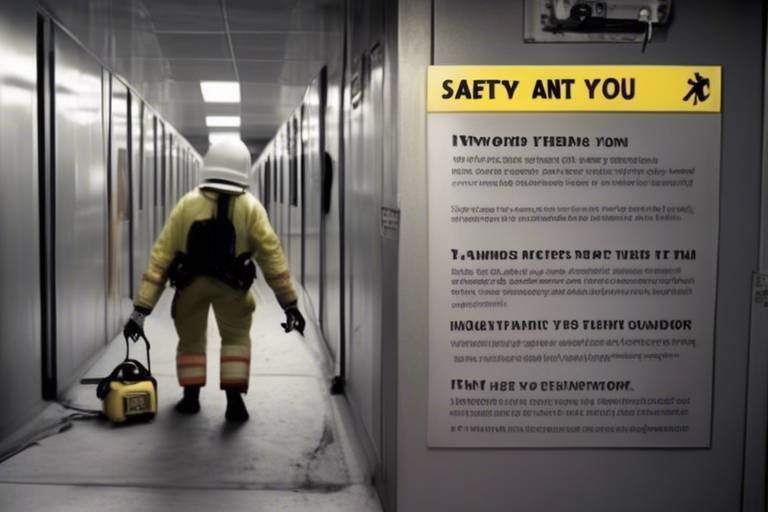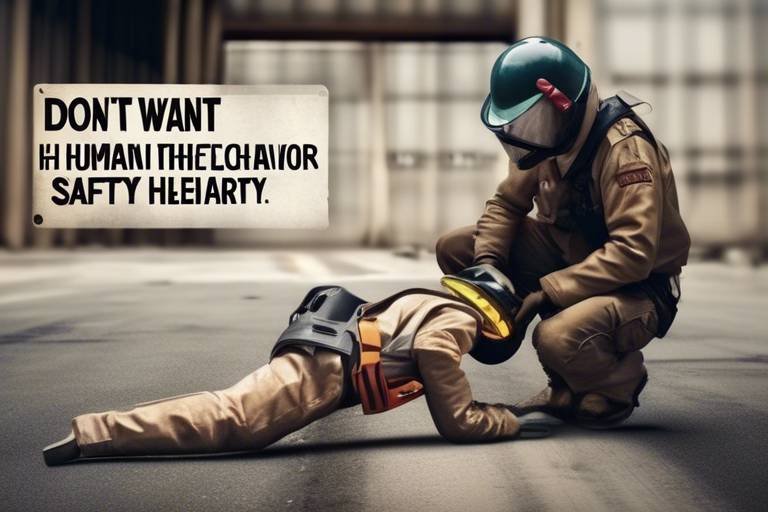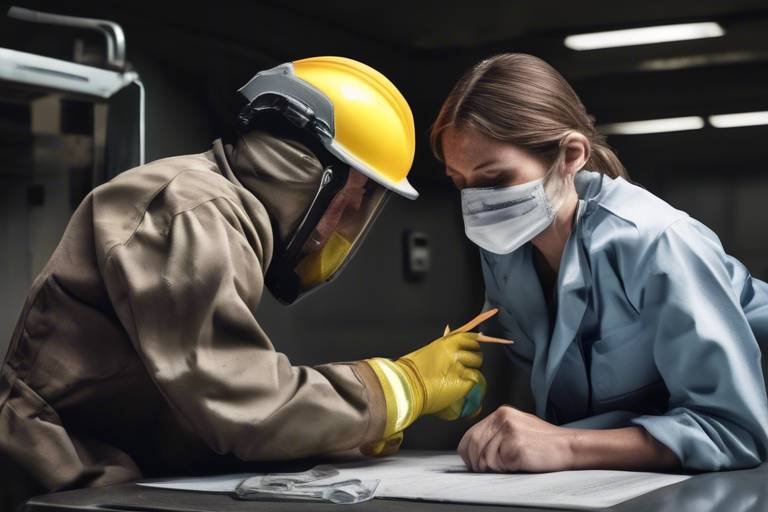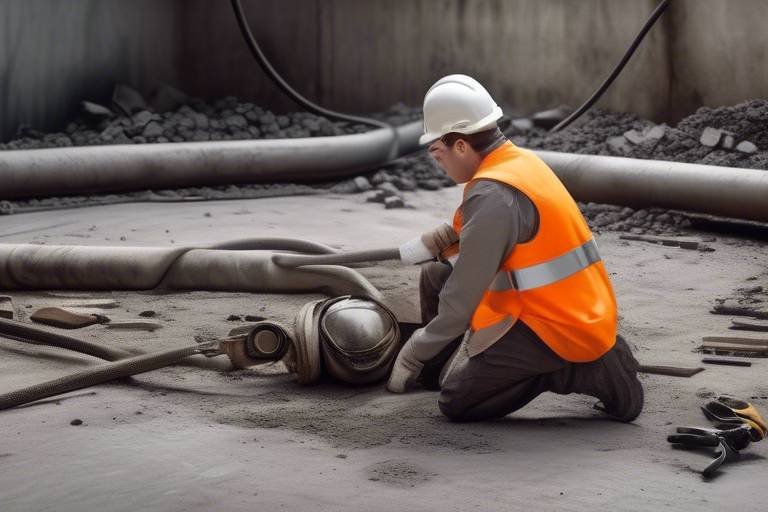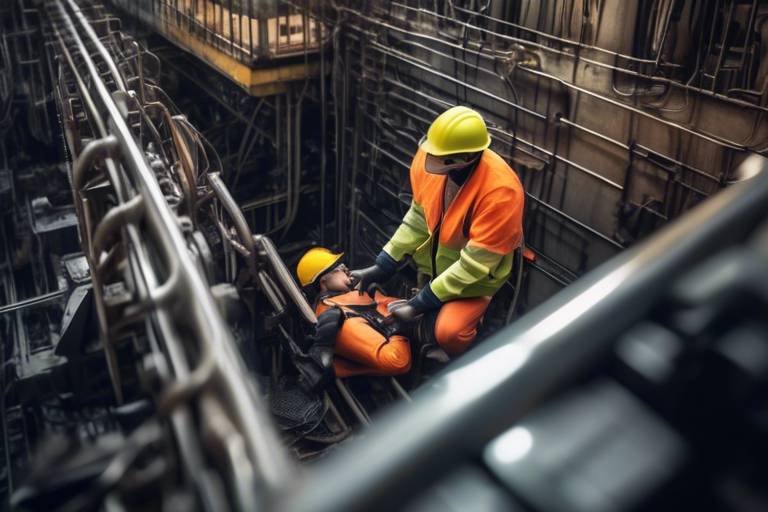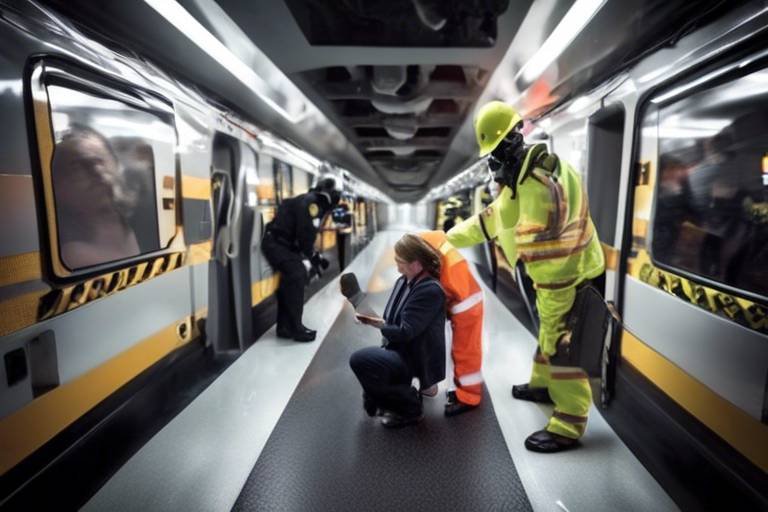Safety Standards, Human Behavior, and the Link between Them
In today's world, the interplay between safety standards and human behavior is more crucial than ever. Think about it: every time you buckle your seatbelt or follow safety protocols at work, you're engaging in a dance between regulations and personal choices. This relationship isn't just theoretical; it has real-world implications that affect our lives, workplaces, and communities. The way we behave in response to safety standards can either bolster our well-being or put us at risk. But what exactly drives this behavior, and how do safety standards shape our actions? Let’s dive deeper into this captivating connection.
Understanding safety standards is crucial for ensuring the well-being of individuals in various environments. These regulations serve as a framework designed to protect us from harm, whether at work, on the road, or in our homes. Imagine walking into a construction site where hard hats, safety vests, and proper signage are mandatory. These are not just arbitrary rules; they are carefully crafted guidelines aimed at minimizing risk and promoting health. When safety standards are followed, the likelihood of accidents decreases significantly. They act as a safety net, catching us before we fall into dangerous situations.
Now, let’s consider the flip side: human behavior. It’s fascinating how our actions can either enhance or compromise safety. For instance, think about a busy highway. Each driver makes individual choices—speeding, texting, or adhering to traffic laws—that collectively impact the safety of everyone on the road. This is where the crux of the matter lies. Our behaviors are often influenced by a mix of personal attitudes, societal expectations, and even emotional states. Understanding this dynamic is essential for developing effective safety protocols.
Delving deeper, we find that psychological factors play a vital role in safety compliance. Our attitudes and perceptions shape how we view risks and safety measures. For example, if someone perceives a safety regulation as unnecessary or overly restrictive, they may be less likely to follow it. Conversely, if they understand the rationale behind a safety standard—perhaps through personal experience or effective communication—they are more likely to comply. This highlights the importance of not just establishing safety standards but also fostering a culture that values and understands them.
Risk perception is another crucial element that influences how we assess dangers. Our personal experiences and societal norms shape our decision-making in safety-critical situations. For instance, someone who has experienced a car accident may be more cautious while driving, whereas someone who has never faced such a situation might underestimate the risks involved. This discrepancy can create a gap in safety compliance that organizations need to address. By enhancing awareness and education, we can bridge this gap and foster safer behaviors.
Behavioral economics provides fascinating insights into how people make safety-related choices. It suggests that our decisions are not always rational and can be influenced by various incentives and disincentives. For instance, if a company offers rewards for safe practices, employees are more likely to engage in behaviors that promote safety. On the other hand, if the consequences for unsafe actions are not clearly communicated, individuals might take unnecessary risks. Understanding these economic principles can help organizations design better safety programs that encourage compliance.
Effective training programs are essential for fostering safe behaviors. When employees are well-informed about the risks they face and the safety measures they should take, they are more likely to act responsibly. Best practices in safety training include interactive sessions, real-life scenarios, and ongoing assessments to ensure that knowledge is retained and applied. Ultimately, investing in training not only enhances compliance but also boosts employee morale and performance.
Organizational culture significantly affects safety practices. A strong safety culture can lead to improved compliance and reduced accidents. When employees feel that safety is a priority within their organization, they are more likely to adhere to safety standards. This culture is fostered through clear communication, consistent policies, and visible commitment from leadership. In essence, a safety-oriented culture can transform the way individuals perceive and act on safety regulations.
Leadership commitment is crucial for establishing a safety-oriented culture. Leaders set the tone for safety practices within an organization. When leaders prioritize safety and model appropriate behaviors, employees are more likely to follow suit. It’s like a ripple effect—leadership actions create waves that influence the entire organization. By actively engaging in safety discussions and demonstrating a commitment to safety standards, leaders can inspire a culture of safety that permeates every level of the organization.
Effective communication enhances safety awareness. It’s not enough to have safety standards in place; organizations must promote open dialogue about safety issues. This can be achieved through regular meetings, safety bulletins, and feedback mechanisms that encourage employees to voice their concerns. When communication flows freely, employees feel empowered to prioritize safety and share their insights, leading to a more informed and safer workplace.
- What are safety standards? Safety standards are guidelines designed to protect individuals and ensure safe practices in various environments.
- How does human behavior impact safety? Human behavior can either enhance or compromise safety depending on individual choices and attitudes towards safety regulations.
- Why is training important for safety? Training helps individuals understand risks and safety measures, promoting compliance and safer behaviors.
- What role does leadership play in safety culture? Leadership sets the tone for safety practices; their commitment influences employee behavior and adherence to safety standards.

The Importance of Safety Standards
Understanding safety standards is crucial for ensuring the well-being of individuals in various environments. These standards serve as a framework designed to protect people from potential hazards, whether in the workplace, at home, or in public spaces. Imagine walking into a construction site without any safety regulations in place; it would be like navigating a minefield blindfolded! Safety standards help to create a structured approach to managing risks, which is essential for preventing accidents and promoting health.
In various industries, safety standards are not just guidelines; they are legal requirements that organizations must adhere to. For instance, in the manufacturing sector, the Occupational Safety and Health Administration (OSHA) sets forth regulations that ensure workers are not exposed to hazardous conditions. Compliance with these regulations not only protects employees but also enhances productivity. When workers feel safe, they are more likely to focus on their tasks without the distraction of potential dangers.
Moreover, safety standards are vital for fostering a culture of accountability. When everyone understands the rules and the reasons behind them, it cultivates a sense of shared responsibility. This is especially important in environments where teamwork is essential. For instance, in healthcare settings, adhering to safety protocols can mean the difference between life and death. A single lapse in following safety standards can lead to catastrophic outcomes, not only for patients but also for healthcare professionals.
Let’s break it down further. Here are some key benefits of implementing safety standards:
- Prevention of Accidents: By establishing clear guidelines, organizations can significantly reduce the risk of accidents and injuries.
- Enhanced Reputation: Companies known for prioritizing safety often enjoy a better reputation, which can lead to increased customer trust and loyalty.
- Financial Savings: Reducing workplace accidents can lead to lower insurance premiums and fewer costs associated with worker compensation claims.
Furthermore, safety standards are dynamic; they evolve as new technologies and research emerge. This adaptability is essential in keeping pace with changing environments and emerging threats. For example, the rise of remote work has led to new safety standards focusing on ergonomics and mental health. Organizations must continuously assess and update their safety protocols to ensure they meet current needs and challenges.
In summary, the importance of safety standards cannot be overstated. They are the backbone of a safe and productive environment, whether in a bustling factory or a quiet office. By prioritizing these standards, we not only protect ourselves but also foster a culture of safety that benefits everyone involved.

Human Behavior in Safety Contexts
When we talk about safety, we often think about rules, regulations, and protocols. But what really drives safety outcomes? It’s human behavior. The way individuals act and make decisions can either bolster safety or create vulnerabilities. Imagine a busy construction site: while hard hats and safety barriers are vital, it’s the workers’ choices that ultimately determine how safe the environment is. Are they following protocols? Are they taking shortcuts? These questions highlight the critical intersection of human behavior and safety.
In various settings, from factories to hospitals, the actions of individuals can have profound implications. For instance, a nurse who skips handwashing to save time can inadvertently put patients at risk. Similarly, a factory worker who ignores safety signs because they believe “it won’t happen to me” may become part of an unfortunate statistic. This illustrates that safety is not just about having rules in place—it’s about whether people choose to follow them.
Moreover, understanding the psychology behind these behaviors can provide valuable insights. Factors such as motivation, attitudes, and perceptions all play significant roles in how individuals approach safety. For example, if a worker believes that their actions contribute to a safer workplace, they are more likely to adhere to safety protocols. Conversely, if they feel that safety measures are burdensome or unnecessary, compliance may suffer.
To further understand this dynamic, let’s consider some psychological factors that influence safety compliance:
- Motivation: Are individuals motivated by a genuine desire to be safe, or are they simply going through the motions?
- Attitudes: Do workers view safety as a priority, or is it seen as an obstacle to productivity?
- Perceptions: How do personal experiences shape one’s view of risk and safety?
These elements are crucial in shaping a culture of safety within organizations. When employees feel valued and understand the importance of safety, they are more likely to engage in safe behaviors. On the flip side, if they perceive safety measures as irrelevant or overly complicated, they may disengage, leading to increased risk.
Another critical aspect is the impact of social norms. If the prevailing attitude among peers is to disregard safety protocols, an individual may feel pressured to conform, even if they know better. This peer influence can be a double-edged sword: it can either reinforce safe practices or undermine them. Therefore, fostering a culture where safety is prioritized and celebrated can significantly alter behavior.
In conclusion, human behavior is a cornerstone of safety in any environment. By recognizing the psychological factors at play and fostering a positive safety culture, organizations can significantly enhance compliance and reduce accidents. After all, safety is not just about rules—it's about people and their choices.

Psychological Factors Influencing Safety
When we think about safety, we often focus on policies, procedures, and equipment. However, the human mind plays a pivotal role in how effectively these elements are implemented. Psychological factors can significantly influence safety compliance and outcomes. For instance, individuals' attitudes towards safety regulations can either motivate them to adhere to protocols or lead them to disregard them altogether. This is where the concept of risk perception comes into play.
Risk perception refers to how individuals assess potential dangers in their environment. It's fascinating to note that this perception is not solely based on statistical data or factual information; rather, it is heavily influenced by personal experiences and societal norms. For example, someone who has previously witnessed an accident may develop a heightened awareness of similar risks, prompting them to take extra precautions. Conversely, if an individual has never encountered a safety incident, they might underestimate the dangers present in their surroundings.
Moreover, the motivation to follow safety protocols can vary greatly from person to person. Some individuals might feel a strong sense of responsibility towards their own safety and that of their colleagues, while others may prioritize their immediate comfort or convenience over safety measures. This difference in motivation can lead to varying levels of compliance with safety standards. It’s essential to recognize that psychological factors are not just individual traits; they can also be shaped by the environment and culture within an organization.
To illustrate the impact of psychological factors on safety, consider the following table that summarizes key elements:
| Psychological Factor | Impact on Safety |
|---|---|
| Risk Perception | Influences how individuals assess and respond to potential dangers. |
| Attitude Towards Safety | Affects adherence to safety protocols and regulations. |
| Motivation | Determines the priority given to safety measures over personal convenience. |
| Social Norms | Shapes individual behavior based on perceived expectations from peers. |
Understanding these psychological factors is crucial for organizations aiming to enhance their safety culture. By fostering an environment that promotes positive attitudes towards safety and addresses individual motivations, organizations can significantly improve compliance with safety standards. Additionally, training programs that incorporate psychological insights can be more effective in changing behaviors and ensuring that safety becomes a shared value among employees.
In conclusion, the interplay between psychology and safety is complex yet vital. By recognizing the importance of psychological factors, organizations can create strategies that not only enhance safety compliance but also cultivate a culture of safety that resonates with every employee. This approach not only protects individuals but also contributes to a more secure and efficient workplace.
- What are psychological factors in safety? Psychological factors in safety include attitudes, perceptions, motivations, and social norms that influence how individuals behave regarding safety protocols.
- How does risk perception affect safety compliance? Individuals with a heightened risk perception are more likely to adhere to safety standards, while those who underestimate risks may neglect necessary precautions.
- Can training improve safety behaviors? Yes, effective training that addresses psychological factors can significantly improve safety behaviors and compliance within an organization.
- What role does organizational culture play in safety? A strong safety culture promotes positive attitudes towards safety and encourages employees to prioritize safety in their daily activities.

Risk Perception and Decision-Making
Risk perception is a fascinating and complex topic that directly influences how individuals assess dangers and make decisions in safety-critical situations. Imagine walking a tightrope: your perception of the risk involved can either propel you forward with confidence or paralyze you with fear. In essence, risk perception shapes our actions and can mean the difference between safety and disaster. For instance, when faced with a hazardous work environment, an individual's background, experiences, and even societal norms play pivotal roles in how they evaluate the situation.
At its core, risk perception is not just about the actual dangers present; it’s also about how those dangers are perceived. People often rely on their personal experiences to gauge risk. If someone has previously encountered an accident in a specific setting, they may overestimate the risk in similar situations in the future. Conversely, if they have navigated a hazardous environment without incident, they might underestimate the potential dangers. This discrepancy can lead to significant variations in decision-making, where some individuals take unnecessary risks while others may act overly cautious.
Moreover, societal norms heavily influence risk perception. In a culture that prioritizes safety, individuals are more likely to adhere to safety standards and protocols. On the other hand, in environments where risk-taking is celebrated, such as extreme sports or certain corporate cultures, people may disregard safety measures altogether. This creates a fascinating dynamic where decision-making is not just a personal affair but is also shaped by the collective mindset of a group. For example, if a workplace promotes a culture of safety, employees are more inclined to report unsafe conditions and adhere to protocols, ultimately leading to a safer environment.
To further illustrate this point, consider the following table that outlines different factors influencing risk perception and their effects on decision-making:
| Factor | Description | Effect on Decision-Making |
|---|---|---|
| Personal Experience | Past encounters with risk | Can lead to overestimation or underestimation of risk |
| Societal Norms | Collective attitudes towards safety | Affects adherence to safety protocols |
| Emotional Response | Fear or confidence levels | Influences risk-taking behavior |
| Information Availability | Access to safety data and guidelines | Enhances awareness and informed decision-making |
In conclusion, understanding the intricacies of risk perception and decision-making is crucial for fostering a culture of safety. By acknowledging the factors that influence how we perceive risks, organizations can tailor their safety training and communication strategies to better equip individuals to make informed decisions. After all, in the world of safety, knowledge is power, and the more we understand our perceptions, the safer we can be.
- What is risk perception? Risk perception refers to the subjective judgment that people make about the characteristics and severity of a risk.
- How does personal experience influence decision-making? Personal experiences can lead individuals to either overestimate or underestimate risks based on their past encounters.
- Why are societal norms important in safety? Societal norms shape collective attitudes toward safety, influencing adherence to safety protocols and behaviors.
- What role does emotional response play in risk perception? Emotional responses, such as fear or confidence, can significantly impact an individual's willingness to take risks.

Behavioral Economics in Safety
Behavioral economics is a fascinating field that blends insights from psychology and economics to better understand how individuals make decisions, particularly in the context of safety. Imagine walking into a construction site where safety helmets are mandatory. You might think, "Why should I wear this? It’s just a hassle." However, behavioral economics helps us unpack this thought process and reveals why people often prioritize convenience over safety. By understanding these tendencies, organizations can design better safety protocols that encourage compliance.
One of the core concepts in behavioral economics is the idea of incentives. Incentives can be powerful motivators that shape our behavior. For instance, consider a workplace that offers rewards for accident-free months. This kind of positive reinforcement can significantly boost safety compliance among employees. On the flip side, the absence of consequences for unsafe behavior can lead to a lax attitude towards safety. It’s like having a speed limit sign on an empty road; without enforcement, many drivers will disregard it, thinking, "What’s the harm?"
Moreover, the concept of loss aversion plays a crucial role in safety-related decision-making. Research shows that people tend to prefer avoiding losses rather than acquiring equivalent gains. In a safety context, this means that if employees perceive the risk of losing their job due to unsafe practices as greater than the inconvenience of following safety protocols, they are more likely to comply. This psychological insight can be leveraged to create a culture of safety where the focus is on what is at stake—such as health and well-being—rather than merely following rules.
Another interesting aspect is the role of social norms. People often look to others when making decisions, especially in a group setting. If an employee sees their coworkers consistently adhering to safety standards, they are more likely to do the same. This is where organizations can benefit from fostering a strong safety culture that promotes positive behaviors. By highlighting stories of individuals who have successfully avoided accidents due to adherence to safety protocols, organizations can create a ripple effect that encourages others to follow suit.
In addition, the design of safety training programs can also be influenced by behavioral economics. Traditional training methods often fail to engage employees fully. Instead, incorporating elements like gamification can make learning about safety more interactive and enjoyable. For example, creating a simulation game that mimics real-life scenarios can help employees understand the consequences of their actions in a safe environment. This not only enhances learning but also increases retention of safety practices.
To sum it up, applying principles of behavioral economics to safety practices can lead to significant improvements in compliance and overall safety outcomes. By understanding how people think and make decisions, organizations can create environments where safety is prioritized and ingrained in the culture. It’s about turning safety from a checkbox activity into a shared value, where everyone feels responsible for their well-being and that of their colleagues.
- What is behavioral economics? Behavioral economics studies how psychological factors influence economic decision-making.
- How can incentives improve safety compliance? Incentives motivate individuals to adhere to safety protocols by rewarding safe behaviors.
- What is loss aversion? Loss aversion is the tendency to prefer avoiding losses over acquiring equivalent gains, which can impact safety-related decisions.
- How do social norms affect safety behavior? Social norms influence individuals by creating expectations based on the behavior of their peers.
- Can gamification improve safety training? Yes, gamification can make safety training more engaging and effective by simulating real-life scenarios.

Training and Education on Safety
When it comes to safety, knowledge is power. Effective training programs are not just a box to check; they are the backbone of a safe workplace. Imagine walking into a factory where every employee knows exactly what to do in case of an emergency. That’s the kind of environment that comprehensive safety training creates. It’s about fostering a culture where safety is a shared responsibility, and everyone plays a part.
Training in safety should be more than just a one-time event. It needs to be an ongoing process that evolves with the industry and the specific risks associated with it. For instance, consider the construction industry, where new tools and techniques emerge frequently. Regular training sessions can ensure that workers are not only aware of the latest safety protocols but are also equipped to handle new equipment safely. This continuous learning approach helps to mitigate risks and enhances overall workplace safety.
Moreover, effective safety training programs often incorporate hands-on practice alongside theoretical knowledge. This dual approach ensures that employees can apply what they learn in real-world scenarios. For example, a company might conduct fire drills to reinforce evacuation procedures. Such practical exercises prepare employees to react swiftly and efficiently in emergencies, potentially saving lives.
To illustrate the impact of training on safety, let’s take a look at some statistics:
| Industry | Accident Rate Before Training | Accident Rate After Training |
|---|---|---|
| Construction | 10.5% | 6.2% |
| Manufacturing | 8.3% | 4.5% |
| Healthcare | 5.1% | 2.7% |
This table showcases how targeted training can significantly reduce accident rates across various industries. As you can see, the difference is not just marginal; it’s substantial. Companies that invest in training not only protect their employees but also save on costs associated with workplace injuries.
Another crucial aspect of safety training is employee engagement. When employees feel involved in the safety process, they are more likely to take it seriously. This can be achieved through interactive training sessions, feedback mechanisms, and even safety committees where employees can voice their concerns and suggestions. Think of it like a sports team; when everyone is invested in the game plan, the chances of winning increase dramatically.
In conclusion, comprehensive training and education on safety are essential for creating a culture of safety in any organization. By prioritizing ongoing training, using practical exercises, and engaging employees, organizations can significantly enhance their safety standards. Remember, a well-trained employee is not just an asset; they are a crucial component of a safer workplace.
- What is the purpose of safety training? Safety training aims to educate employees on how to recognize hazards, understand safety protocols, and respond effectively in emergencies.
- How often should safety training be conducted? Safety training should be ongoing, with regular refreshers at least annually, or more frequently if new risks or equipment are introduced.
- Are hands-on training sessions more effective? Yes, hands-on training allows employees to practice skills in real-life scenarios, which can enhance retention and confidence in applying safety protocols.

The Role of Organizational Culture
When we talk about organizational culture, we’re diving into the very essence of how a company operates. It’s like the soul of an organization, shaping its values, beliefs, and behaviors. Imagine walking into a workplace where safety is a top priority—everyone wears their gear, follows protocols, and looks out for one another. That’s the power of a strong safety culture! It not only encourages compliance with safety standards but also fosters an environment where employees feel valued and empowered to speak up about safety concerns. This cultural framework can significantly influence safety practices and outcomes.
In industries where risks are inherent, such as construction or manufacturing, a robust safety culture can be the difference between a safe work environment and a hazardous one. For instance, companies that prioritize safety often see a decrease in accidents, which can lead to lower insurance costs and higher employee morale. It’s a win-win situation! But how do you cultivate such a culture? It all starts with leadership.
Leadership commitment is crucial for establishing a safety-oriented culture. Leaders set the tone for safety practices through their actions and policies. When leaders demonstrate a genuine commitment to safety—by participating in training, conducting safety audits, and addressing safety concerns promptly—employees are more likely to follow suit. It’s like a ripple effect; when leaders prioritize safety, employees feel encouraged to do the same. This commitment should be visible at all levels of the organization, from top executives to front-line workers.
Moreover, effective communication plays a pivotal role in enhancing safety awareness. It’s not just about having safety meetings or posting rules on a bulletin board. Open dialogue about safety issues is essential. Employees should feel comfortable discussing potential hazards or suggesting improvements without fear of retribution. A culture that promotes open communication leads to increased safety awareness and proactive behavior. For example, regular safety briefings can serve as a platform for sharing experiences and lessons learned, reinforcing the importance of safety in everyone’s daily tasks.
To further illustrate the importance of organizational culture in safety, consider the following table that outlines key elements and their impact:
| Key Element | Impact on Safety |
|---|---|
| Leadership Commitment | Sets the tone for safety practices and inspires employees to prioritize safety. |
| Open Communication | Encourages reporting of hazards and sharing of safety ideas, leading to improved practices. |
| Employee Training | Equips employees with the knowledge and skills needed to work safely and effectively. |
| Recognition and Rewards | Motivates employees to engage in safe behaviors and reinforces the importance of safety. |
In summary, the role of organizational culture in safety cannot be overstated. It’s the foundation upon which safe practices are built. By fostering a culture that prioritizes safety through strong leadership, effective communication, and ongoing training, organizations can not only comply with safety standards but also create a workplace where employees feel secure and valued. Remember, safety is not just a set of rules; it’s a mindset that permeates every aspect of the organization.
- What is organizational culture? Organizational culture refers to the shared values, beliefs, and behaviors that shape how members of an organization interact and work together.
- How can leadership influence safety culture? Leaders can influence safety culture by demonstrating a commitment to safety, participating in safety initiatives, and encouraging open communication about safety concerns.
- Why is communication important for safety? Effective communication promotes awareness of safety issues, encourages reporting of hazards, and fosters a collaborative environment where employees feel empowered to contribute to safety improvements.
- What are some effective ways to promote safety training? Regular training sessions, interactive workshops, and incorporating real-life scenarios can enhance the effectiveness of safety training and ensure employees are well-prepared.

Leadership and Safety Culture
Leadership plays a pivotal role in shaping the safety culture within organizations. When leaders prioritize safety, they set a powerful example for their teams, influencing not only policies but also the everyday behaviors of employees. Imagine a ship at sea; the captain’s actions steer the vessel, and similarly, a leader's commitment to safety can guide the entire organization toward a safer working environment.
Effective leaders understand that safety is not just a checkbox to tick off during meetings; it’s a core value that must be embedded into the organization's DNA. They communicate the importance of safety through consistent messaging and by integrating safety goals into the overall strategic objectives of the company. This means that safety is not viewed as a separate function but as an integral part of the business—just like productivity and profitability.
To foster a robust safety culture, leaders can employ several strategies:
- Modeling Safe Behavior: Leaders should demonstrate safe practices in their daily routines. When employees see their leaders wearing protective gear, following safety protocols, and prioritizing safety in discussions, they are more likely to adopt similar behaviors.
- Open Communication: Creating an environment where employees feel free to voice safety concerns is essential. Leaders should encourage feedback and actively listen to their teams, reinforcing the idea that safety is a shared responsibility.
- Recognition and Reward: Acknowledging and rewarding safe behavior can motivate employees to prioritize safety. When leaders celebrate safety milestones or recognize individuals for exemplary safety practices, it reinforces the importance of safety within the organization.
Moreover, the commitment of leadership to safety can be reflected in policies and resource allocation. For instance, investing in training programs, safety equipment, and regular safety audits demonstrates that the organization values the well-being of its employees. It’s like watering a plant; without nourishment, growth is stunted. In the same way, without proper investment in safety, an organization cannot expect a thriving safety culture.
Furthermore, leaders should engage in continuous improvement. Safety standards and practices should evolve based on feedback, incident reports, and changes in regulations. By prioritizing safety as an ongoing process rather than a one-time initiative, leaders can cultivate a culture that not only reacts to incidents but proactively seeks to prevent them.
In conclusion, the influence of leadership on safety culture cannot be overstated. A strong safety culture emerges when leaders actively prioritize safety, communicate its importance, and model safe behaviors. As organizations strive to enhance their safety practices, it’s crucial for leaders to recognize their role as safety champions, guiding their teams toward a safer and more productive environment.
Q1: How can leaders effectively communicate safety standards to their teams?
A1: Leaders can communicate safety standards through regular meetings, training sessions, and by integrating safety discussions into everyday conversations. Utilizing visual aids and providing written materials can also reinforce these messages.
Q2: What role does employee feedback play in shaping safety culture?
A2: Employee feedback is vital as it provides insights into potential hazards and areas for improvement. When leaders actively seek and respond to feedback, it fosters a sense of ownership and responsibility among employees regarding safety.
Q3: How can organizations measure the effectiveness of their safety culture?
A3: Organizations can measure the effectiveness of their safety culture through employee surveys, incident reports, safety audits, and tracking safety performance metrics over time. This data helps identify trends and areas needing improvement.

Communication and Safety Awareness
Effective communication is the backbone of safety awareness in any organization. It's not just about relaying information; it's about creating a culture where safety is prioritized and everyone feels empowered to speak up. Imagine a workplace where every employee is not only aware of the safety protocols but also actively engaged in discussions about them. This kind of environment fosters a sense of ownership and responsibility towards safety. But how do we achieve this?
First and foremost, it’s essential to establish clear lines of communication. This can be achieved through regular safety meetings, where employees can voice their concerns and share their experiences. These meetings should be structured yet informal enough to encourage open dialogue. For instance, incorporating a segment where employees can share near-miss incidents can be incredibly beneficial. It not only raises awareness but also allows others to learn from those experiences, ultimately preventing future accidents.
Additionally, utilizing various communication channels can greatly enhance safety awareness. Whether it's through emails, newsletters, or digital platforms, the key is to ensure that safety messages are consistently reinforced. Visual aids, such as posters and infographics, can also be powerful tools in conveying important safety information. For example, a simple infographic outlining the steps to take in case of an emergency can be more effective than a lengthy manual. The goal is to make safety information accessible and easy to understand.
Moreover, feedback loops are crucial in maintaining effective communication. Organizations should encourage employees to provide feedback on safety practices and communication methods. This not only helps in identifying areas for improvement but also demonstrates that the organization values its employees' input. When workers see that their suggestions lead to tangible changes, it boosts morale and encourages more proactive engagement in safety matters.
Incorporating technology can also play a significant role in enhancing safety communication. For instance, mobile apps designed for safety reporting can facilitate immediate reporting of hazards or unsafe conditions. This kind of technology not only streamlines the communication process but also ensures that safety issues are addressed promptly. Imagine an employee spotting a potential hazard and being able to report it with just a few taps on their smartphone. This immediacy can be a game-changer in preventing accidents.
Lastly, it’s vital to recognize the diversity within the workforce. Different individuals may have varying levels of understanding and familiarity with safety protocols. Therefore, tailoring communication to meet the needs of all employees is essential. This could mean providing information in multiple languages or using simple, jargon-free language to ensure clarity. By doing so, organizations can create an inclusive environment where everyone feels informed and safe.
In summary, fostering a culture of safety awareness through effective communication is not just beneficial; it’s essential for the well-being of all employees. By encouraging open dialogue, utilizing various communication channels, and embracing technology, organizations can significantly enhance their safety practices. Remember, safety is a collective effort, and every voice matters!
- How can I improve safety communication in my workplace?
Regular safety meetings, feedback loops, and utilizing technology can significantly enhance communication. - What role does leadership play in safety communication?
Leadership sets the tone for safety culture; their commitment to open communication encourages employees to engage actively. - Why is feedback important in safety practices?
Feedback helps identify areas for improvement and shows employees that their input is valued, fostering a sense of ownership. - How can technology aid in safety awareness?
Mobile apps for reporting hazards and digital platforms for sharing safety information streamline communication and enhance awareness.
Frequently Asked Questions
- What are safety standards and why are they important?
Safety standards are established guidelines and regulations designed to ensure the health and safety of individuals in various environments. They play a crucial role in preventing accidents and promoting overall well-being, whether in workplaces, public spaces, or at home. By adhering to these standards, organizations and individuals can significantly reduce the risk of injuries and enhance safety.
- How does human behavior impact safety?
Human behavior is a major factor in safety outcomes. The way individuals act and make decisions can either enhance or compromise safety. For instance, a person’s willingness to follow safety protocols or their reaction in emergency situations can greatly influence the effectiveness of safety measures in place.
- What psychological factors affect safety compliance?
Several psychological factors influence safety compliance, including attitudes, perceptions, and motivations. Individuals may perceive risks differently based on their past experiences or societal influences, which can affect their commitment to following safety standards. Understanding these psychological elements is essential for improving safety behaviors.
- How does risk perception influence decision-making?
Risk perception plays a vital role in how individuals assess dangers and make decisions in safety-critical situations. Personal experiences, cultural norms, and the information available can shape one’s understanding of risks, ultimately affecting choices related to safety. For example, someone who has previously experienced a workplace accident may be more cautious than someone who hasn't.
- What is behavioral economics and how does it relate to safety?
Behavioral economics studies how psychological factors influence economic decisions, including those related to safety. It suggests that the design of incentives and disincentives can effectively promote safer behavior. For instance, reward systems for safe practices can encourage individuals to adhere to safety standards more diligently.
- Why is training important for safety?
Effective training programs are essential for fostering safe behaviors among employees. When individuals are well-informed about safety protocols and procedures, they are more likely to comply with them. Training enhances awareness, builds confidence, and ultimately leads to improved performance and a safer environment.
- How does organizational culture affect safety practices?
Organizational culture significantly influences safety practices within a company. A strong safety culture promotes compliance with safety standards and reduces the likelihood of accidents. When safety is prioritized at all levels of an organization, employees are more likely to engage in safe practices and report safety concerns.
- What role does leadership play in establishing a safety culture?
Leadership commitment is crucial for fostering a safety-oriented culture. Leaders set the tone for safety practices through their actions and policies. When leaders actively promote safety and demonstrate their commitment, employees are more likely to follow suit and prioritize safety in their daily activities.
- How can communication enhance safety awareness?
Effective communication is key to enhancing safety awareness within organizations. Open dialogue about safety issues encourages employees to share concerns and suggestions. By fostering an environment where safety is openly discussed, organizations can identify potential hazards and improve overall safety practices.

